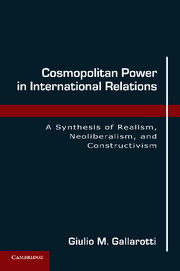 Cosmopolitan Power in International Relations
Cosmopolitan Power in International Relations Published online by Cambridge University Press: 05 June 2012
Optimizing Power Through Diversification, a Model of Optimal Diversification among Hard and Soft Power Resources
Let us assume that nations wish to optimize influence through some investment in power resources. Assume that they can employ two kinds of resources: hard (HP) and soft (SP). These can be thought of as factors in the production of international influence and depicted as isoquants I1…I4 (see Figure 6). These influence curves represent all combinations of HP and SP for a given level of influence, so they are functions of HP and SP. The curves are convex over the factors of production, suggesting the standard structure of diminishing marginal productivity in factors of production. This is consistent with the depiction of standard returns to the application of power resources in the international relations literature on power, as it is posited that as we move toward the extremes (i.e., where nations are predominantly relying on one set of power resources), nations will have to substitute increasingly greater amounts of the prevalent resources for the lesser-used resources to maintain the same level of influence. This is depicted by a flattening of the curves in relation to the respective axes as we move away from the origin (Nye 2002, 162; Keohane and Nye 1989, 11). Movement along any influence curve represents the same level of influence at differing combinations of power resources, or the marginal rate of substitution among inputs dSP/dHP, alternatively the marginal rate of technical substitution. Higher levels of influence are attained as one moves out from the origin to higher influence curves. The full amount of resources that a nation may bring to bear on investing in influence can be depicted by a standard isocost line or budget constraint, defined as f(HP,SP) with standard slope – PHP/PSP. It represents all combinations of hard and soft power that can be purchased by a nation given their prices PHP and PSP. The constraint B2 in Figure 6 represents a larger budget than B1 and therefore makes higher levels of influence attainable.
To save this book to your Kindle, first ensure [email protected] is added to your Approved Personal Document E-mail List under your Personal Document Settings on the Manage Your Content and Devices page of your Amazon account. Then enter the ‘name’ part of your Kindle email address below. Find out more about saving to your Kindle.
Note you can select to save to either the @free.kindle.com or @kindle.com variations. ‘@free.kindle.com’ emails are free but can only be saved to your device when it is connected to wi-fi. ‘@kindle.com’ emails can be delivered even when you are not connected to wi-fi, but note that service fees apply.
Find out more about the Kindle Personal Document Service.
To save content items to your account, please confirm that you agree to abide by our usage policies. If this is the first time you use this feature, you will be asked to authorise Cambridge Core to connect with your account. Find out more about saving content to Dropbox.
To save content items to your account, please confirm that you agree to abide by our usage policies. If this is the first time you use this feature, you will be asked to authorise Cambridge Core to connect with your account. Find out more about saving content to Google Drive.